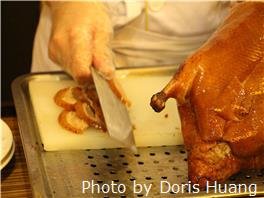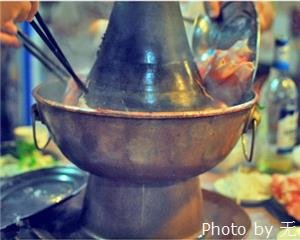Certain dishes are eaten during the Chinese New Year for their symbolic meaning. Lucky food is served during the 16-day festival season, especially New Year’s Eve, which is believed to bring good luck for the coming year. The auspicious symbolism of these foods is based on their pronunciations or appearance.
Not only do the dishes themselves matter, but also the preparation, and ways of serving and eating mean a lot.
The most common Chinese New Year foods includes dumplings, fish, spring rolls, and niangao.
Fish 鱼 Yú /yoo/
In Chinese, "fish" sounds like 'surplus'. Chinese people always like to have a surplus at the end of the year, because they think if they have managed to save something at the end of the year, then they can make more in the next year.
Fish can be cooked in various ways such as boiling, steaming, and braising. The most famous Chinese fish dishes include steamed weever, West Lake fish with pickled cabbage and chili, steamed fish in vinegar sauce, and boiled fish with spicy broth.
The Meaning of Various Fish
What fish should be chosen for the New Year feast is based on auspicious homophonics.
Crucian carp: As the first character of ‘crucian carp' (鲫鱼 jìyú \jee-yoo\) sounds like the Chinese word 吉 (jí /jee/ ‘good luck'), eating crucian carp is considered to bring good luck for the next year.
Chinese mud carp: The first part of the Chinese for “mud carp” (鲤鱼 lǐyú /lee-yoo/) is pronounced like the word for gifts (礼 lǐ /lee/). So Chinese people think eating mud carp during the Chinese New Year symbolizes wishing for good fortune.
Catfish:The Chinese for “catfish” (鲶鱼 niányú /nyen-yoo/) sounds like 年余 (nián yú) meaning ‘year surplus'. So eating catfish is a wish for a surplus in the year.
Eating two fish, one on New Year's Eve and one on New Year's Day, (if written in a certain way) sounds like a wish for a surplus year-after-year.
If only one catfish is eaten, eating the upper part of the fish on New Year's Eve and the remainder on the first day of the new year can be spoken with the same homophonic meaning.
How a Fish Is Eaten Matters a Lot
The fish should be the last dish left with some left over, as this has auspicious homophonics for there being surpluses every year. This is practiced north of the Yangtze River, but in other areas the head and tail of the fish shouldn't be eaten until the beginning of the year, which expresses the hope that the year will start and finish with surplus.
There are some rules related to the position of the fish.
The head should be placed toward distinguished guests or elders, representing respect.
Diners can enjoy the fish only after the one who faces the fish head eats first.
The fish shouldn't be moved. The two people who face the head and tail of fish should drink together, as this is considered to have a lucky meaning.
These customs are observed in a lively and light-hearted spirit, full of laughing and banter.
Chinese Dumplings 饺子 Jiǎozi /jyaoww-dzrr/
With a history of more than 1,800 years, dumplings are a classic Chinese food, and a traditional dish eaten on Chinese New Year's Eve, widely popular in China, especially in North China.
Chinese dumplings can be made to look like Chinese silver ingots (which are not bars, but boat-shaped, oval, and turned up at the two ends). Legend has it that the more dumplings you eat during the New Year celebrations, the more money you can make in the New Year.
Dumplings generally consist ofminced meat and finely-chopped vegetables wrapped in a thin and elastic dough skin. Popular fillings are minced pork, diced shrimp, fish, ground chicken, beef, and vegetables. They can be cooked by boiling, steaming, frying or baking.
How they're made:Almost all Chinese people can make dumplings. First they mix the dough, second make the dough into round "wrappers" with a rolling pin, third fill the wrappers with stuffing, fourth pinch the "wrapper" together into the desired shape, and fifth cook them.
Different Dumpling Fillings Have Different Meanings
Chinese don't eat Chinese sauerkraut (酸菜 suāncài /swann-tseye/) dumplings at Spring Festival, because it implies a poor and difficult future. On New Year's Eve it is a tradition to eat dumplings with cabbage and radish, implying that one's skin will become fair and one's mood will become gentle.
How to Make LUCKY Dumplings
When making dumplings there should be a good number of pleats. If you make the junction too flat, it is thought to purport poverty.
Some Chinese put a white threadinside a dumpling, and the one who eats that dumpling is supposed to possess longevity. Sometimes a copper coin is put in a dumpling, and the one who eats it is supposed to become wealthy.
Dumplings should be arranged in lines instead of circles, because circles of dumplings are supposed to mean one's life will go round in circles, never going anywhere.
Lucky Saying for Eating Dumplings
Zhāo cái jìn bǎo (招财进宝/jaoww tseye jin baoww/): 'Bringing in wealth and treasure' — a felicitous wish for making money and amassing a fortune.
Spring Rolls 春卷 Chūnjuǎn /chwnn- jwen/
Spring rolls get their name because they are traditionally eaten during the Spring Festival. It is a dish especially popular in East China: Jiangxi, Jiangsu, Shanghai, Fujian, Guangzhou, Shenzhen, Hong Kong, etc.
Spring rolls are a Cantonese dim sum dish of cylindrical-shaped rolls filled with vegetables, meat, or something sweet. Fillings are wrapped in thin dough wrappers, then fried, when the spring rolls are given their golden-yellow color.
Lucky Saying for Eating Spring Rolls
黄金万两 (hwung-jin wan-lyang/): 'A ton of gold' (because fried spring rolls look like gold bars) — a wish for prosperity.
Niángāo — (Glutinous Rice Cake) 年糕 (/nyen-gaoww/)
In Chinese, niangao sounds like it means "'getting higher year-on- by year"'. In Chinese people's minds, this means e higher you are the more prosperous your business isa general improvement in life. The main ingredients of niangao are sticky rice, sugar, chestnuts, Chinese dates, and lotus leaves.
Lucky Saying for Eating Niangao
年年高 (niánnián gāo /nyen-nyen gaoww/): 'Getting higher year-after-year by year', can imply children's height, rise in business success, better grades in study, promotions at work, etc.
Tāngyuán — Sweet Rice Balls (汤圆 /tung-ywen/)
Tangyuan is the main food for China's Lantern Festival, however, in south China, people eat them throughout the Spring Festival. The pronunciation and round shape of tangyuan are associated with reunion and being together. That’s why they are favored by the Chinese during the New Year celebrations.
Lucky Sayings for Eating Tangyuan
团团圆圆 (Tuántuán yuányuán /twann-twann ywen-ywen/ 'group-group round-round'): Happy (family) reunion!
Longevity Noodles 长寿面 (chángshòu miàn /chung-show myen/)
Longevity noodles unsurprisingly symbolize a wish for longevity. Their length and unsevered preparation are also symbolic of the eater's life.
They are longer than normal noodles and uncut, either fried and served on a plate, or boiled and served in a bowl with their broth.
Good Fortune Fruit
Certain fruits are eaten during the Chinese New Year period, such as tangerines and oranges, and pomeloes. They are selected as they are particularly round and "golden" in color, symbolizing fullness and wealth, but more obviously for the lucky sound they bring when spoken.
Eating and displaying tangerines and orangesis believed to bring good luck and fortune due to their pronunciation, and even writing. The Chinese for orange (and tangerine) is 橙 (chéng /chnng/), which sounds the same as the Chinese for 'success' (成). One of the ways of writing tangerine (桔 jú /jyoo/) contains the Chinese character for luck (吉 jí /jee/).
Eating pomeloes/shaddocks is thought to bring continuous prosperity. The more you eat, the more wealth it will bring, as the traditional saying goes. The Chinese for pomelo (柚 yòu /yo/) sounds like 'to have' (有 yǒu), except for the tone, and exactly like 'again' (又 yòu).
Popular New Year Food for 2015
As 2015 is the year of the goat, goat dishes will be very popular. A very auspicious goat dish — San Yang Kai Tai — 'three goats bring wealth' (三羊开泰 sān yáng kāi tài /san yang kigh tigh/), is a very good food for Chinese New Year 2015.
San Yang Kai Tai used to be a New Year saying to wish good luck. The Chinese for "goat" (羊) is in a Chinese character for good luck (祥 xiáng /sshyang/). The character 泰 (tài /tigh/) means 'peace' and 'grand'. San Yang Kai Tai is also a 'National Painting', and would make a good Chinese New Year decoration for 2015.
The dish is a goat and radish stew, whose main ingredients are goat meat, cabbage, radish, green onion, ginger, salt, and water.













